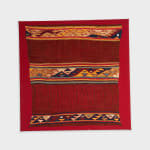Chancay Culture 1000-1470
Decorated Gauze Panel, Circa. 1000 - 1425 AD
Camelid fibres
76 x 76 cm
29'9" x 29'9" in
29'9" x 29'9" in
CHA0018
Copyright of Paul Hughes Fine Arts
Further images
Chancay textiles are extraordinarily varied and, almost without exception, executed with remarkable virtuosity. From gauzes and openwork embroidery to painted plain weave and tapestry, the weavers explored some of the...
Chancay textiles are extraordinarily varied and, almost without exception, executed with remarkable virtuosity. From gauzes and openwork embroidery to painted plain weave and tapestry, the weavers explored some of the most technically demanding techniques. Openwork, which ultimately derives from the ancient coastal fishing tradition of net-making, reached new heights of lacy intricacy. On most gauze and openwork cloths, only the weaver could see the motifs during their creation, as the threads pulled together when not under the tension of the loom. As a result, once the textile was removed from the loom, its designs often became illegible—especially when the piece was folded, as in women’s headcloths. This characteristic reflects the Andean value placed on essence over appearance.
Join our mailing list
* denotes required fields
We will process the personal data you have supplied in accordance with our privacy policy (available on request). You can unsubscribe or change your preferences at any time by clicking the link in our emails.







